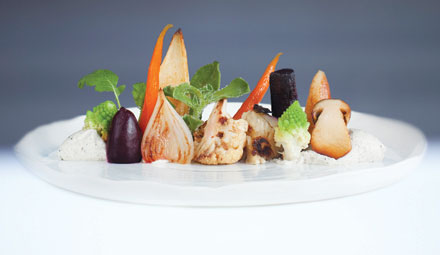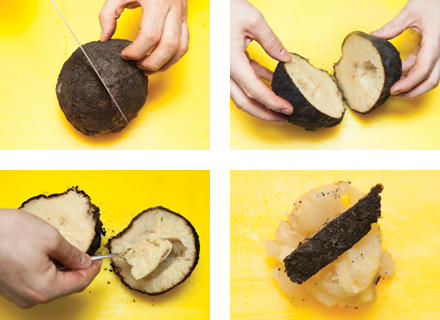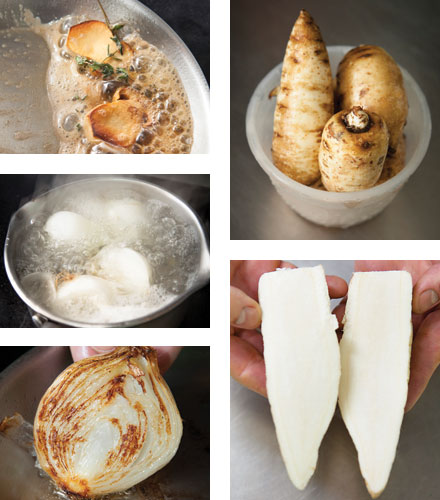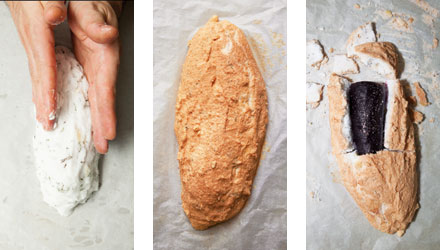Masterclass: Winter salad
Tim Allen's winter salad at the Michelin-starred Launceston Place restaurant in London takes advantage of the fantastic choice brought by the growing popularity of vegetables in British restaurants and the imaginative application of techniques. Michael Raffael reports
When someone comes to write a history of British restaurants, they will probably pick out 2013 as the year chefs discovered vegetables. Instead of just figuring as an add-on, a garnish or something to accompany the protein centrepiece of the dish, they became its focus. The once humble vegetable rose in the pecking order of desirable foods.
At one level, the choice offered by growers, greengrocers and foragers has multiplied. Even for something as basic as, say, a carrot, there are new varieties, rainbow colours and assorted sizes and shapes for the chef to choose from. Add to this the race to find a micro-leaf salad green or something off the seashore, and the palette of new ingredients grows still larger.
Potentially even more interesting is the application of techniques not traditionally encountered in cooking vegetables. Salt-baking, ash-baking, papillotes, pickling, fermenting, juicing, glazing and a dozen other preparations may not, in themselves, be terribly new, but the ways in which chefs have started to apply these techniques are. There's also more care being taken over the seasoning, the spices and flavourings picked to match ingredients.
Tim Allen's winter salad is a mind-blowing mix of all these themes pulled together. Few kitchens would aspire to put so many carefully composed elements on the same plate. What matters more is that each part of the recipe works on its own terms.
PLANNING The Launceston Place batch size is based on 50 covers per service.
Elements that can be prepared in advance: Celeriac and cauliflower: on the day, but ahead of service.
Papillote beets (but glazed to order).
Pickled carrots (but glazed to order).
Salt-baked purple carrot: baked on the day, but ahead of service.
Onions: blanched ahead, but browned to order.
Romanescu, Hamburg parsley and chervil root: steamed to order.
Truffle spread: prepared ahead of service.
COSTING Because his winter salad is a dish notable for its complexity rather than the individual cost of the raw materials, Allen says that he hasn't worked out the precise recipe cost. He is, though, able to slot it into an overall 68% GP on his menu.
As well as serving the winter salad on his à la carte, although not on his tasting menus, Allen is able to serve scaled-down versions on his lunch menus, working with any elements that are to hand.
CHARCOAL-BAKING
CELERIAC Allen started using a Big Green Egg charcoal-fired oven when working with Daniel Clifford at Midsummer House in Cambridge, and the ash-baked celeriac recipe came originally from Clifford.
Ingredients
Method Vacuum-pack the celeriac on full. Steam at 100°C for three hours. Cool, and then remove it from the plastic.
Put the celeriac directly on the hot charcoal in the Big Green Egg at 150°C. Bake for two hours, turning the celeriac around regularly until it has an all-over charred crust.
When the celeriac is cool enough to handle, slice it in half. Scoop out a dessertspoonful per portion. Season and top with a small shard of charred crust (above).
CAULIFLOWER FLORETS
Use about 1kg - that's about one floret per portion. These are cooked directly on the cast-iron searing grate for one hour.
PAPILLOTE
Launceston Place prepares about 40 red and 40 candy (chioggia) beets, weighing about 50g each. When cooking them, leave a little of the stalk attached to prevent the beets bleeding. These will be enough for 80 servings.
RED BEETROOTIngredients
40 baby beets
400ml beetroot juice
1 large star anise
7 juniper berries
1 clove
8g coriander seeds
5cm cinnamon
15g Maldon salt
Method Place a rack in a 2/1 gastronorm baking tray. Lay a sheet of foil on top that is large enough to seal the beets, and then put a sheet of silicone on top. Spread the beets on this and add the juice and seasonings. Seal and bake for 90 minutes at 180°. Cool.
Trim, peel and halve the beets. Boil the liquid until it reduces to a sticky glaze. Be careful not to caramelise the liquid - the flavour changes dramatically if you do. Reserve in a squeezy bottle for service.
CANDY BEETROOT (CHIOGGIA)
Ingredients 40 candy beets
400ml apple juice
1tsp dried pink peppercorns
2g caraway seeds
15g Maldon salt
Method Place a rack in a 2/1 gastronorm baking tray with a sheet of foil on top large enough to seal the beets. Put a sheet of silicone on this. Spread the beets on it and add the juice and seasonings. Seal and bake for one hour at 180°C. Cool. Trim, peel and halve the beets. Boil the liquid until it's a sticky glaze. Reserve in a squeezy bottle for service.
SEARING
CEPS
Choose button ceps with bulbous stems weighing about 30g each. Slice in half lengthways for two portions.
Method Heat 20g butter in a frying pan with a pinch of crushed garlic and a sprig of thyme. When they sizzle, add the halved cep, sliced surface down, and sear until caramelised. Butter-baste to prevent burning. Season.
WHITE ONION
Choose smallish onions (about 100g without skin). Typically, 20 onions yield 40 portions.
Ingredients
2 litres water
40g salt
100g sugar
About 15g butter per portion (seared to order)
Method Bring the water, salt and sugar to the boil with the onions and simmer till softening - five to 10 minutes . Cool and halve. For each portion, fry a half in hot butter till coloured and peel away the outer layer - it can be used for stock .
CHERVIL ROOT One per portion, about the size of a thumb. Peel and blanch for about three minutes in boiling salted water. Drain and fry in butter till lightly coloured. Season. This root vegetable has a mild aniseed taste, like the herb.
HAMBURG PARSLEY ROOT
Wash and scrub the root, which is about the size and shape of a small parsnip . Cut it into two lengthways and then blanch till al dente - it should take about seven minutes. Drain and fry in butter till lightly coloured. Season. Hamburg parsley root has a strong parsley taste, reminiscent of the stalks.
SALT-BAKING
BLACK (PURPLE) CARROT
Warning: don't substitute ordinary carrot - it will be too salty prepared this way.
Choose mature carrots weighing about 120g each (about four portions). Launceston Place may prepare 10 per batch. The quantity of salt crust ingredients will vary according to the number of carrots being prepared. Stick to the proportions, sufficient for about four carrots.
Ingredients
1kg salt
100g egg white
2 cloves garlic
6g thyme leaves
6g rosemary, chopped
4 black (purple) carrots
Method Preheat a convection oven to 180°C. Make a paste with the salt, the egg white and the herbs. Pack the carrots into this. Bake for at least 15 minutes until the crust has turned golden brown. Cool the crust and then break it open and remove the carrots. Brush off any salt on the surface.
STEAMING
ROMANESCU Break up the romanescu into small florets weighing about 10g each (maybe a little less). Steam for four minutes and season.
PICKLED AND GLAZED CARROTS
Pickle about 40 baby carrots as part of the basic preparation and finish them in the mustard and honey glaze to order. The honey mustard is a different recipe to dress the plate at the end.
Ingredients for the pickle
375ml water
250g liquid honey
25ml white wine vinegar
100ml white wine
1tsp caster sugar
Sprig of thyme
3 cloves garlic
Method Bring the ingredients for the pickle to the boil, stirring to dissolve them. Remove from the heat, allow to cool and finely sieve. Lightly steam the prepared baby carrots and place in a saucepan. Cover with the pickling liquor, bring to a boil and reduce until they are sticky. Reserve.
For the mustard and honey glaze
225g liquid honey
180g white wine vinegar
80g Pommery mustard
1 sprig of thyme
Method Boil the ingredients for the mustard glaze until reduced. Cool, remove the thyme and store in a squeezy bottle.
TRUFFLE SPREAD
The ingredients here are enough for about 10 portions - scale up as necessary.
Ingredients 50g puréed mushroom duxelle (diced mushrooms stewed with shallots)
18g summer truffle shavings, finely diced
6ml white truffle oil
Squeeze of lemon juice to taste
Salt
150g cream cheese
Method
Mix all the ingredients together so they can be shaped into quenelles (two per portion).
PORTION PLATING
1dsp celeriac
1/2 red beet
1/2 candy beet
1/2 parsley root
1 chervil root
2 glazed carrots with mustard dressing
20g approx purple carrot
1 onion, halved and caramelised
1/2 sautéed cep
2 romanescu florets
1 cauliflower floret
2 quenelles of truffle spread
TO FINISH
Add a sprig of iceplant (mesembryanthemum crystallinum), turnip leaf, slice of raw cep and, if in season, roasted and chopped chestnuts.
TIM ALLEN
At the start of 2012, within months of taking the helm at D&D London's Launceston Place, where he is effectively its chef-patron, Tim Allen garnered a Michelin star. This year he picked up a fourth AA rosette.
Daniel Clifford at Midsummer House or Martin Burge of Whatley Manor, two of his past bosses, won't have been surprised by his rapid success.
They know, from watching him in action, that their ex-sous chef shares an obsession for detail, for technical precision and for giving food great depth of flavour and a dramatic look.
What he has added to this formidable armoury is his own personal taste, small touches that give bite and subtlety to otherwise commonplace ingredients.
















